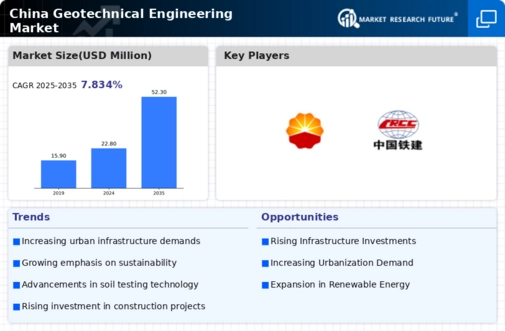Natural Disaster Mitigation
China's vulnerability to natural disasters such as earthquakes, landslides, and floods drives the demand for geotechnical engineering services. The geotechnical engineering market plays a crucial role in disaster risk reduction by providing essential data for site assessments and designing resilient structures. In recent years, the government has increased funding for disaster preparedness and response, with an estimated $50 billion allocated for infrastructure improvements in high-risk areas. This investment underscores the importance of geotechnical studies in enhancing the safety and resilience of buildings and infrastructure. As climate change continues to exacerbate weather-related events, the geotechnical engineering market is likely to see heightened demand for innovative solutions that address these challenges.
Government Infrastructure Initiatives
The Chinese government's commitment to infrastructure development significantly influences the geotechnical engineering market. Initiatives such as the Belt and Road Initiative (BRI) and the New Urbanization Plan aim to enhance connectivity and promote economic growth. In 2023, the government allocated approximately $200 billion for infrastructure projects, which includes substantial investments in transportation, energy, and urban development. These initiatives create a robust demand for geotechnical engineering services, as thorough site investigations and soil assessments are essential for the successful execution of large-scale projects. The ongoing focus on infrastructure development suggests a sustained growth trajectory for the geotechnical engineering market in the coming years.
Environmental Regulations and Compliance
Increasing environmental regulations in China are shaping the geotechnical engineering market by necessitating compliance with stringent standards. The government has implemented various policies aimed at reducing environmental impact, which require thorough geotechnical assessments to ensure sustainable construction practices. In 2023, approximately 30% of construction projects faced delays due to non-compliance with environmental regulations, highlighting the critical role of geotechnical engineering in meeting these requirements. As the regulatory landscape evolves, the demand for specialized geotechnical services that address environmental concerns is likely to grow. This trend indicates a shift towards more responsible engineering practices, further driving the geotechnical engineering market.
Technological Integration in Construction
The integration of advanced technologies in construction processes is reshaping the geotechnical engineering market in China. Innovations such as Building Information Modeling (BIM), geospatial analysis, and automated monitoring systems enhance the accuracy and efficiency of geotechnical assessments. In 2023, the adoption of these technologies has been linked to a 20% reduction in project timelines and a 15% decrease in costs associated with geotechnical investigations. As construction firms increasingly recognize the benefits of technology, the geotechnical engineering market is expected to expand, driven by the need for precision and reliability in engineering solutions. This trend indicates a shift towards more data-driven decision-making in the industry.
Urbanization and Infrastructure Development
The rapid urbanization in China is a primary driver for the geotechnical engineering market. As cities expand, the demand for robust infrastructure increases, necessitating advanced geotechnical solutions. The construction of high-rise buildings, bridges, and transportation networks requires extensive geotechnical assessments to ensure stability and safety. In 2023, the construction sector in China accounted for approximately 7.5% of the GDP, highlighting the economic significance of infrastructure projects. This growth is expected to continue, with investments in urban infrastructure projected to reach $1 trillion by 2025. Consequently, the geotechnical engineering market is poised to benefit from this trend, as engineers and contractors seek innovative solutions to address the challenges posed by urban development.













Leave a Comment